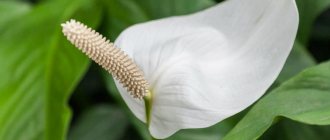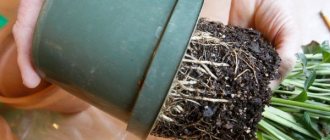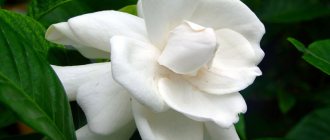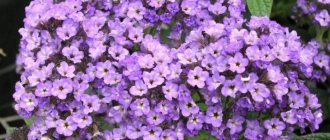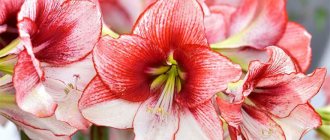Description and appearance
spathiphyllum flower - home care, the secret of success
Spathiphyllum domino is a hybrid obtained as a result of breeding work on the spathiphyllum plant. Belongs to the Araceae family. The peculiarity of the flower is that it has practically no stems; its lanceolate-oval green leaves with white streaks grow directly from the soil. Arrows with amazing flowers also appear from the ground. The stems can reach a height of 40 centimeters.
The flower blooms profusely
During the flowering period, the plant emits a very pleasant aroma. Due to the long flowering period, spathiphyllum is also called “women’s happiness.”
History of origin
Handsome Picasso is a hybrid bred on the basis of Spathiphyllum Wallis, one of the most common species of this plant. The latter bears the name of its discoverer Henry Wallis, a writer and botanist who created the first scientific description of spathiphyllums. The unusual plant was discovered by scientists during a scientific expedition to South America, from where it was subsequently brought to Europe.
Spathiphyllum Wallis was very fond of European breeders who worked on creating new varieties and hybrids of exotic plants for growing at home. At the same time, botanists also sought to endow them with external originality.
So in the second half of the 20th century, new varieties were bred from Spathiphyllum Wallis, including the Picasso hybrid.
Medicinal properties
Medinilla flower: home care and propagation methods
Spathiphyllum secretes biologically active substances that help a person relieve stress. It has phytoncidal properties and is able to purify the air from microbes and fungi hovering in it.
Note! Spathiphyllum is poisonous because its leaves contain calcium oxalate, which causes irritation of the mucous membranes and inflammation of the eyes. When cleaning, you should use gloves.
Picasso
Spathiphyllum picasso are huge, uneven creamy-white spots on the leaf blades, sometimes occupying most of it. The variegated color and spreading bush, the particular unpretentiousness and charm of the variety made it popular in magazine photography, for example in IKEA catalogs. You can see what the Spathiphyllum Picasso variety looks like in the photo below:
Spathiphyllum Picasso
How to distinguish from other species
Spathiphyllum Domino has an uneven leaf color - green with white streaks. Spathiphyllum variety Gemini differs from the Domino variety - these two species have very different leaves. Spathiphyllum Gemini jemini has green leaves with light green streaks.
Green leaves of spathiphyllum Domino
The streaks are larger and located to the sides of the middle of the leaf in the form of a herringbone. The difference between Spathiphyllum Picasso picasso and Domino or gemini is that there are differences in the leaves. In Picasso they are painted more white. There are leaves on the bush with large white stripes and completely white ones.
Similar plants
There is another flower that is similar in appearance to anthurium - calla lily.
It has the same dark green lush leaves, bright ears and large spathes, which can be of various colors: yellow, white, pink, purple, lilac. Their main similarity is that bracts of this shape can take on the most unusual colors. Red spathiphyllum (anthurium) is the most unusual indoor plant due to the abundance of color shades that the bract can take on. But at the same time, the plant requires no more attention than an ordinary spathiphyllum.
It’s just important to remember that anthurium juice is very poisonous, and therefore needs to be handled with extreme care.
Home care
Care for spathiphyllum Domino at home requires compliance with certain rules.
Temperature
During the active growing season, the optimal temperature is –22-24 C °.
Luxurious spathiphyllum leaves
In winter, during the dormant period, – +16-17°C.
Lighting
The Domino variety needs a lot of diffused light; it needs to be shaded from active sunlight. Keeping the flower in the shade will worsen the quality of flowering and reduce the decorative properties of the leaves.
Watering
In the warm season, the flower is watered once every 2-3 days, in winter - once a week. For irrigation, use only purified and warm water.
Important! Abundant watering will provide the plant with real decorative beauty of leaves and flowering.
Spraying
In summer it is better to spray the plant every day, in winter – once every 3-4 days.
Humidity
Spathiphyllum Domino needs high air humidity - at least 40%.
Moistening a flower with a spray bottle
It is also worth wiping the leaves with a sponge and warm water.
Priming
Special soil mixtures are suitable for planting; they can be purchased at a flower shop. You can also prepare the soil yourself. The composition should include peat, leaf soil, humus, sand, crushed tree bark and charcoal. Everything is taken in equal parts.
Feeding
Fertilizing is carried out with complex liquid fertilizers. Fertilizing should be done during the active growing season and flowering period. To maintain the beauty of the leaves, nitrogenous fertilizers can be added to the soil once every two weeks.
Care during the rest period
Before the formation of buds, it is worth applying potassium-phosphorus fertilizer once every 14-20 days. After flowering, it is necessary to reduce the amount of watering and not apply fertilizers, since in winter the plant is in a dormant period.
Care during flowering
During flowering, it is important to remove all inflorescences that have faded; this will help preserve the decorative appearance of the bush and promote new release of buds.
Trimming
Pruning is carried out as necessary if there are limp or dry leaves, as well as after flowering has ended. Cut off all flower stalks that have already bloomed.
Transfer
The plant is transplanted into a new pot along with an old lump of earth. After transplantation, the flower is watered, fertilizing is applied only after 3 weeks.
Picture 8 Transplanting into a new pot
1.Seven secrets of success:
| 1. Growing temperature: in summer - very warm content at a temperature of 21 to 24 ° C, winter - a slight decrease in temperature to 16 - 18. |
| 2. Lighting: spathiphyllum enjoys bathing in the sun's rays in the morning and evening hours in spring and summer; in autumn and winter, choose the most illuminated place. During the daytime, it is better to protect plants from sunlight. |
| 3. Watering and air humidity: a well-moistened substrate during the growing season; in spring and summer, the top 2 cm of the substrate is dried between waterings. In winter, according to the room temperature, water only with softened water. Air humidity is high. |
| 4. Pruning: sanitary - removing old leaves and faded buds along with flower stalks as they form. |
| 5. Soil: should have a slightly acidic pH and good drainage; for spathiphyllum, the correct soil is loose. air- and moisture-permeable soil. |
| 6. Feeding: during the entire growing season, feed 2 times a month with fertilizers for flowering plants. In the cold winter months, the frequency of fertilizing is reduced to once a month or not done at all. |
| 7. Reproduction: by dividing large plants into several parts during spring transplantation, by apical cuttings in spring and summer. |
Botanical name: Spathiphyllum.
Spathiphyllum domestica - family.
Homeland of the plant. Central America.
Description. The genus “spathiphyllum” or female happiness consists of approximately 35 species of perennial, herbaceous, evergreen plants.
The leaves are basal, on long, thick petioles, spear-shaped, up to 25 cm long, dark green, glossy, with reticulate-pinnate venation.
The flowers are small, collected in an inflorescence - a spadix, surrounded by a large blanket of white, red, yellow, orange, pink or even almost black. Each flower can last for several weeks. Some varieties during the flowering period emit a pleasant aroma reminiscent of hyacinth.
There are variegated species.
Height. The size of the plant can vary greatly depending on the variety. Spathiphyllum flower can grow up to 20 – 60 cm. It develops quickly.
Reproduction options
Spathiphyllum can be grown from seeds or propagated by rooting cuttings or dividing the bush.
Picture 7 Spathiphyllum Domino in a pot
Germination of seeds
The seeds of the plant are placed in a prepared substrate consisting of garden soil and river sand. The plantings are covered with film and left at a temperature of +18-20 degrees. When the first shoots appear, the temperature is lowered to +10-15 degrees. Water as the top layer of soil dries.
Rooting cuttings
Young stems are selected from the bush and cut at a right angle. All leaves are removed from the lower part, treated with a root growth stimulator and planted in the ground. During the rooting period, the plantings are covered with film. When the cuttings take root, you need to remove the cover and care for it like an adult plant.
Part of a bush
The bush is removed from the pot and divided into several parts. Next, all parts of the bush need to be transplanted into new pots and watered well. Apply fertilizer after 1 month.
Approximate prices
As a result of the fact that all types of plants are equal in size, the difference in price is small. Prices start from 600 rubles. for young and small plants. Large, overgrown spathiphyllums cost about 3 thousand rubles. In addition, if a flower has buds, this increases its value.
Plants are sold individually or in sets. For example, an assortment consisting of nine types will cost approximately 6–7 thousand rubles. Such sets are suitable for offices, gardeners, collectors and as gifts.
Possible problems during cultivation
Although Domino spathiphyllum is unpretentious in care, the following troubles can occur with it.
Drops buds and leaves
Spathiphyllum gets sick from a draft and drops its leaves. You need to take care of the plant and not place it on windows that are opened for ventilation in winter.
The leaves are turning pale
If there is a lack of complex mineral fertilizers, the flowers on the plant will become smaller, the leaves will turn pale and growth will slow down.
The tips of the leaves are drying out
The reason is dry air. You need to constantly spray and use a humidifier. Yellowing of leaves can also occur when watering with hard water or due to insufficient moisture in the soil.
No flowering
The reason is not enough light, watering or fertilizer. You also need to promptly remove faded inflorescences.
The lower leaves fall off
The reason is the presence of insect pests. It is necessary to treat the bush with tobacco crumbs.
Pests
Most often the flower is affected by:
- Spider mites - use insecticides;
- Scale – treat with tobacco crumbs;
- Aphids - use chemicals;
- Mealybug - treat leaves with alcohol.
Why doesn't it bloom?
Whether the plant will delight you with its flowers or not directly depends on how well the plant is cared for. If spathiphyllum does not bloom for a long time, then there are reasons for this.
Let's consider all possible options for the absence of flowering:
- The container is too empty. In a large pot, the plant spends energy developing the root system, and therefore, instead of beautiful flowers, you get new leaves.
- The plant loves bright light, but this does not mean that it should be placed in open sunlight.
- Spathiphyllum is very afraid of drafts; if you forget about this, the plant will not only stop blooming, but may soon get sick and die.
- Excessive watering also causes the plant to become diseased rather than bloom.
- Dry air and infrequent watering also have an adverse effect on spathiphyllum.
- A lack of nutrients in the soil will also have a bad effect on the flower.
- Improper care can lead to various diseases and pests.
For reference! The old plant does not produce flowers; in order for it to make you happy again, you just need to plant it. And the spathiphyllum will bloom again.
What to do?
To understand why the plant does not bloom, you need to pay attention to care; perhaps the reason lies precisely in it. For example:
- Insufficient moisture.
- Excess or lack of lighting.
- Insufficient amount of fertilizer.
- There may be a transfer error.
If this is the reason, then it is enough to correct the mistake and the plant will begin to please you. Another reason for the lack of flowering in spathiphyllum may be diseases or pests, which also need to be dealt with in a timely manner.
Read about how often spathiphyllum blooms at home, when this process begins and how to help the plant.
Signs and superstitions
It is believed that if spathiphyllum enters the house, then women will find happiness: unmarried women will get married, married women will find harmony in their relationships.
Spathiphyllum Domino in a pot
Additional Information. The flower will help you find understanding with your partner, and will also eliminate all quarrels between residents of the house of different age categories.
When caring for spathiphyllum, you need to adhere to all the rules of growing, then it will delight you with snow-white flowers and an amazing aroma for a long time.
Variegated color and white stripes: how to care for spathiphyllum “Domino”
Every gardener cares about his own collection of plants and strives to increase it. Often the pride of a collection is not the rare flowers, but those plants that are found everywhere, but in good hands they grow and bloom especially luxuriantly. Thin, graceful spathiphyllum, a flower that has earned the name “female happiness,” is a rare plant, but beautiful and grateful. It must be well cared for to achieve rich flowering.
There are ordinary types of spathiphyllum, and there are its hybrids that look especially exotic. Let's find out in detail about spathiphyllum "Domino" - a variegated, striking beauty.
Recommended by topic
Phlox Saintpaulia Zephyranthes Another fatal disease is black rot - with it, the leaves seem to be sucked out from the inside, they become thinner and turn black. The remaining symptoms coincide with late blight. Spathiphyllum can be attacked by sooty fungus, a disease that affects petioles and leaves. It looks like a dark brownish coating on the underside of the leaf and petiole; the further development of the disease coincides with previous fungal diseases. Fungi are very difficult to treat; they spread too quickly. Do not allow the soil to become waterlogged, and if the fungus does infect your flower, fight it with Topsin-M or Fitosporin-M. All tools and pots are sterilized with potassium permanganate, the affected roots are cut off and powdered with charcoal. It is better to process on the balcony or outside.
Why does spathiphyllum not bloom, what should I do?
Yes, many gardeners complain about some capriciousness of this beautiful flower.
But remember that although spathiphyllum is classified as a rather unpretentious plant, each flowering for each plant is a very stressful matter, it uses up the flower’s strength. If the spathiphyllum does not bloom, it means: either there is no strength, or it is being spent on something else. In winter there will be no strength, do not try to force it to bloom - the flower will have nowhere to replenish its food reserves in winter.
Check the following:
- Do you comply with all conditions of detention?
- Is the plant warm enough?
- When was the last time fertilizing was done?
- How many old leaves does it have?
- Is the season appropriate for your variety to bloom?
If necessary, replant and sanitary pruning your plant, examine for pests and the quality of the root system.
Spathiphyllum Chopin
One of the most popular and useful varieties of Chopin spathiphyllum, Spathiphyllum Chopin, is a universal, unpretentious plant for decorating residential interiors and landscaping offices and public buildings. The plant copes well with the task of absorbing harmful substances in the air. At the same time, the bush is very small and barely reaches 35–40 cm in height.
This variety of spathiphyllum has deep green, shiny leaves with depressed veins and pointed ends. The perianth is elongated, white, with a green tip and veins.
In addition, in the first half of the day a subtle aroma spreads from the plant, which undoubtedly adds attractiveness to the crop in the eyes of gardeners.
